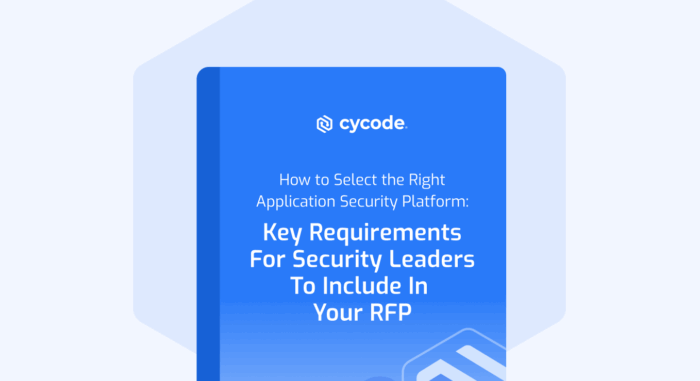The Application Security market is undergoing a shift in the age of Artificial Intelligence. Application Security Testing (AST), Software Supply Chain Security (SSCS), and Application Security Posture Management (ASPM) platforms are rapidly evolving and converging into a single solution space, resetting the entire application security space.
Many factors drive this consolidation. Application security has never been more critical or complex. Security leaders must eliminate coverage gaps, distill overwhelming alerts into exploitable risk-based priorities, protect software supply chains, and inform actions that measurably improve outcomes with less time, effort, and cost.
This is easier said than done. Finding a solution that aligns with your present and future enterprise needs requires incisive questions to inform evaluation and decision-making criteria. Based on experiences partnering with Fortune 500 customers to improve outcomes, Cycode’s RFP template will help you identify core requirements, uncover key differences, and confidently select a vendor that meets your complete needs — now and as you scale. Read on to understand the key questions to answer in your evaluation journey.
Application Security Platform RFP Template: Key Requirements
Platform Architecture: Does the solution meet your enterprise needs?
An effective platform should be built on a scalable architecture that supports multi-tenant environments, flexible deployment models, and real-time data processing. Whether cloud, on-premise, or hybrid, deploying an Application Security Platform successfully starts with identifying solutions that conform to your enterprise needs and architecture. Beyond flexible deployment options, look for solutions that work with your single-sign-on and authentication platforms, scale to satisfy enterprise demands, and provide security attestation and compliance.
SDLC Discovery and Inventory: Does the solution automatically discover and continuously inventory assets across your SDLC?
You can’t protect what you can’t see. Your Application Security solution should automatically discover applications, services, and assets across the SDLC—from code and pipelines to deployed environments. Continuous inventory creation enables visibility into your actual attack surface, not just what’s documented, so you can close gaps and prevent shadow risk.
Application Security Testing (AST): Does the solution simplify developer workflows and support consolidation?
An effective platform should offer proprietary capabilities for code security, including Static Application Security Testing (SAST) and Software Composition Analysis (SCA). These tools should integrate security analysis of proprietary code and open-source dependencies seamlessly within the developer workflow. Look for solutions that provide high accuracy with minimal false positives, fast scan times, and actionable results that help teams fix issues early before they reach production. Proprietary testing capabilities facilitate tighter integration, simplify complex technology stacks, and offer more options to improve ROI.
Software Supply Chain Security (SSCS): Does the solution protect against intensifying software supply chain threats?
The software supply chain–inclusive of open-source dependencies and the SDLC toolchain–is under increasing threat. Your Application Security platform should continuously scan for vulnerabilities, license issues, and misconfigurations across SDLC tools—all while mapping findings to the code owners and pipelines responsible.
Application Security Posture Management: Does the solution unify data across the SDLC and process it into contextual insights?
While Application Security Platforms should offer native and proprietary AST and SSCS capabilities, it should also connect to CI/CD, SCM, ticketing systems, cloud environments, and security tools to unify fragmented AppSec data. Of course, data alone isn’t valuable. Data with context is. The right platform normalizes, enriches, and correlates data to reduce noise and surface meaningful insights. Look for intuitive dashboards, customizable views, and search/query capabilities that enable your teams to explore data and collaborate on the fly.
Risk Analysis & Prioritization: Can the platform distill large volumes of findings into clear risk-based priorities?
Finding issues isn’t enough. You need to cut through the noise to know what issues matter most. Application Security platforms should correlate findings across tools and stages, then apply risk scoring based on exploitability, reachability, asset criticality, and business context. The goal is clear, defensible prioritization that drives action, not alert fatigue.
Remediation & Workflows: Does the solution enable developer-friendly remediation?
True value comes from fixing issues quickly and efficiently. Evaluate how each platform supports remediation through automated tickets, integrations with developer tools, and AI-generated fixes. Bonus points for solutions that combine no-code workflows, AI fixes, and developer tool integrations to streamline remediation without disrupting developer productivity.
Metrics, Reporting, and Compliance: Does the platform deliver metrics and reports to track posture, prove compliance, and drive continuous improvement?
Security leaders need to measure progress and prove value. Your platform should offer robust reporting capabilities, including compliance mapping, customizable KPIs, and executive-ready dashboards. Ensure it supports evidence gathering for audits and offers insights to track security posture over time.
Application Security Platform RFP Template – Download Now
Choosing the right solution isn’t just about checking boxes—it’s about future-proofing your Application Security strategy. As application environments become more complex and the stakes grow higher, your ability to centralize visibility, automate risk reduction, and empower developers with actionable intelligence is key. This RFP template will help you ask the right questions, challenge vendor assumptions, and align stakeholders around a solution that delivers lasting impact.
Download the Application Security Platform RFP Template now to accelerate your evaluation and make a confident, informed decision.
